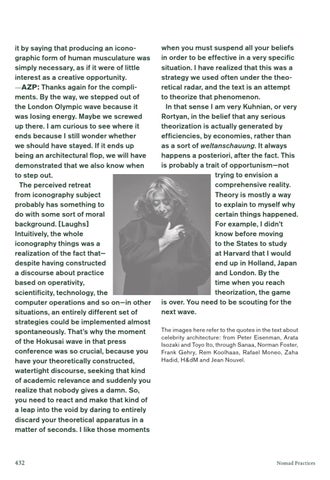it by saying that producing an iconographic form of human musculature was simply necessary, as if it were of little interest as a creative opportunity. —AZP: Thanks again for the compliments. By the way, we stepped out of the London Olympic wave because it was losing energy. Maybe we screwed up there. I am curious to see where it ends because I still wonder whether we should have stayed. If it ends up being an architectural flop, we will have demonstrated that we also know when to step out. The perceived retreat from iconography subject probably has something to do with some sort of moral background. [Laughs] Intuitively, the whole iconography things was a realization of the fact that— despite having constructed a discourse about practice based on operativity, scientificity, technology, the computer operations and so on—in other situations, an entirely different set of strategies could be implemented almost spontaneously. That’s why the moment of the Hokusai wave in that press conference was so crucial, because you have your theoretically constructed, watertight discourse, seeking that kind of academic relevance and suddenly you realize that nobody gives a damn. So, you need to react and make that kind of a leap into the void by daring to entirely discard your theoretical apparatus in a matter of seconds. I like those moments
432
when you must suspend all your beliefs in order to be effective in a very specific situation. I have realized that this was a strategy we used often under the theoretical radar, and the text is an attempt to theorize that phenomenon. In that sense I am very Kuhnian, or very Rortyan, in the belief that any serious theorization is actually generated by efficiencies, by economies, rather than as a sort of weltanschauung. It always happens a posteriori, after the fact. This is probably a trait of opportunism—not trying to envision a comprehensive reality. Theory is mostly a way to explain to myself why certain things happened. For example, I didn’t know before moving to the States to study at Harvard that I would end up in Holland, Japan and London. By the time when you reach theorization, the game is over. You need to be scouting for the next wave. The images here refer to the quotes in the text about celebrity architecture: from Peter Eisenman, Arata Isozaki and Toyo Ito, through Sanaa, Norman Foster, Frank Gehry, Rem Koolhaas, Rafael Moneo, Zaha Hadid, H&dM and Jean Nouvel.
Nomad Practices
